Do preschoolers get bored with routine tasks? Are you running out of fresh, fun ideas? Want to spark creativity while supporting learning goals in the classroom?
Art activities for preschoolers aren’t just about keeping little hands busy. They play a vital role in early childhood development—enhancing creativity, fine motor skills, sensory processing, language growth, and emotional expression. Through themed and seasonal projects, kids not only have fun but build cognitive connections that last a lifetime.
Every child has an inner artist. But without guidance, materials, or seasonal inspiration, that creativity may stay hidden. This guide unlocks 50+ of the best year-round art activities designed to engage young minds and support their growth—one colorful project at a time.
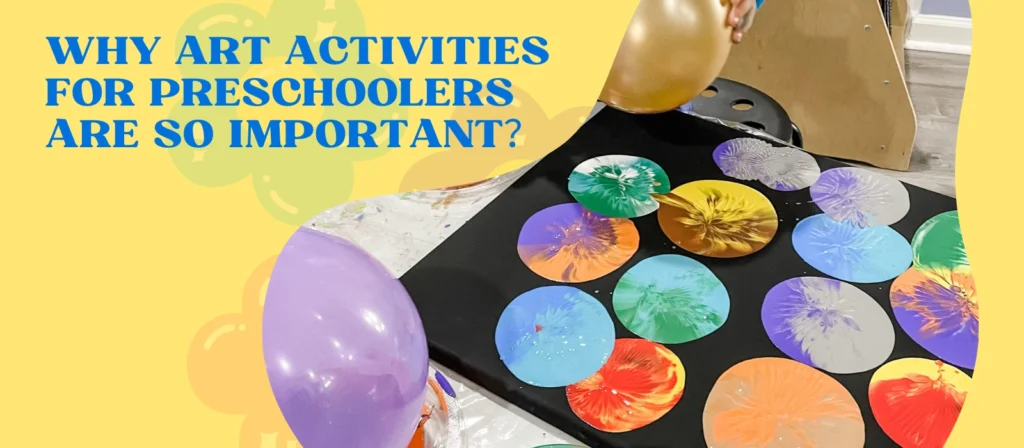
Why Art Activities for Preschoolers Are So Important
Art is more than play—it’s a powerful learning tool. In the preschool years, children’s brains are forming trillions of connections. Art activities support this development by encouraging experimentation, decision-making, and critical thinking. Whether they’re painting, cutting, gluing, or drawing, kids are strengthening the neural pathways that support both academic learning and emotional health.
Art also builds fine motor skills by developing hand-eye coordination and muscle control. When preschoolers use scissors, hold paintbrushes, or shape clay, they’re improving the precision they’ll later use for writing.
Beyond physical development, art offers a safe and exciting way for children to express feelings they may not yet have the vocabulary for. It fosters confidence, patience, and a willingness to try again—skills essential not just for school, but for life.
Art activities in group settings help promote social interaction and cooperation. Working side by side on creative projects teaches sharing, communication, and appreciation for others’ perspectives.
Most importantly, art is joyful. When children are engaged in meaningful, enjoyable work, they’re more open to learning. With thoughtful planning, art activities can reinforce themes like seasons, holidays, animals, or letters—helping to integrate creativity across the early childhood curriculum.
To help you bring this creativity into your classroom, the rest of this article is divided into seasonal and thematic sections. From spring bugs to winter snowmen, from ocean life to community helpers, we’ll explore 50 of the best art activities for preschoolers—each designed to inspire, educate, and entertain.
Spring Art Activities for Preschoolers
Spring is a season full of renewal, color, and sensory excitement—making it a perfect backdrop for preschool art activities. During this season, children are naturally curious about bugs, flowers, rain, and the changes they see outdoors. Art can help them explore these themes in a hands-on and memorable way.
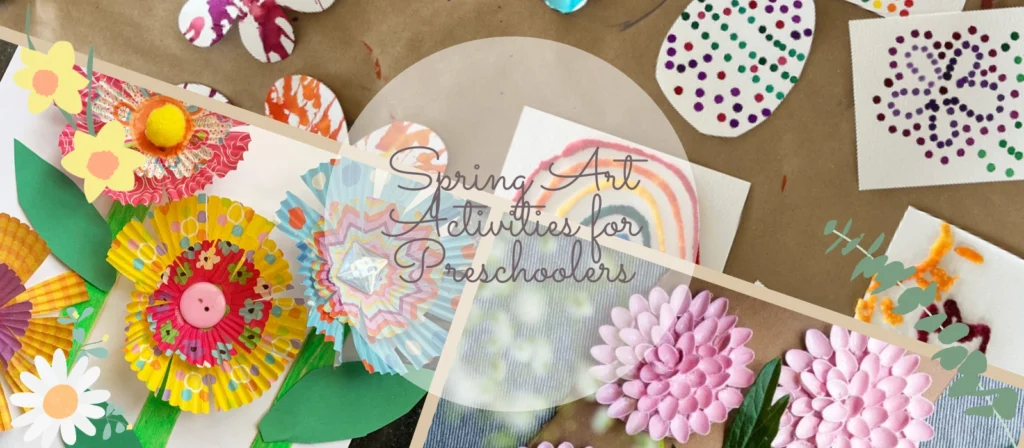
1. Easter Egg Painting and Bunny Crafts
Let preschoolers decorate paper or foam eggs with watercolors, stickers, and glitter. Use cotton balls to make fluffy bunny tails or have children assemble bunny faces with construction paper and googly eyes. These activities improve fine motor skills and let children explore soft textures and bright spring colors.
2. Bug-Themed Crafts: Butterflies, Ladybugs, Bees
Insect crafts are always a hit. Try coffee filter butterflies with watercolor and clothespins, or paper plate ladybugs with movable wings. Bumblebee crafts using toilet paper rolls and yellow paint can add a 3D component. These bug art activities for preschoolers also tie into early science lessons on insect life cycles.
3. Rain & Umbrella Splatter Art
Simulate rainy weather with splatter painting. Let children create rain by flicking diluted blue paint onto paper with toothbrushes. Cut umbrella shapes out of construction paper and glue them on top. This type of activity is especially good for sensory integration and expressive creativity.
4. Earth Day Recycled Crafts
Use Earth Day as a chance to teach sustainability. Let preschoolers create collages from scraps, bottle caps, and cardboard. Create paper mache globes or paint on used paper bags. These eco-friendly art activities foster environmental awareness at an early age.
See more Earth Day ideas at EarthDay.org.
5. Gardening and Tree Projects
Create tissue paper flowers, seed packet collages, and tree trunk paintings using sponge prints. These activities connect children with nature and help them observe plant life cycles while improving pattern recognition and spatial awareness.
6. Letter S, R, B Art for Spring Themes
Integrate literacy with letter-based crafts like “S is for Sun,” “R is for Rainbow,” and “B is for Bee.” These types of projects reinforce letter recognition and phonics while maintaining seasonal relevance.
For alphabet integration ideas, visit Pre-K Pages.
7. Spring-Themed Process Art
Try open-ended activities like pastel color blending with cotton balls, or fingerprint blossom trees. Letting children explore materials freely enhances their creativity and decision-making without the pressure of a ‘perfect’ product.
Summer Art Activities for Preschoolers
Summer brings bright sunshine, vibrant colors, and opportunities for outdoor fun—making it an ideal season for dynamic and imaginative art experiences. Preschoolers are full of energy during these months, and art can help focus their creativity while connecting with summertime themes.
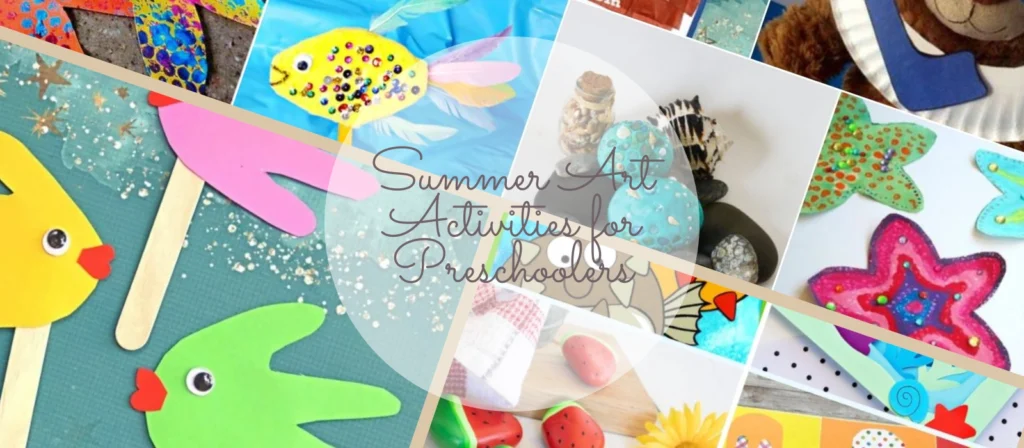
1. Ocean & Under the Sea Projects
Encourage children to create fish, jellyfish, turtles, or octopuses using construction paper, cupcake liners, and yarn. Use bubble wrap printing to mimic the texture of ocean waves. These ocean art activities for preschoolers tie perfectly into marine life exploration and water safety week.
2. Ice Cream and Watermelon Crafts
Cut out cone shapes and let children use pom-poms or paint to make their own ice cream scoops. Create watermelon slices with red tissue paper, black buttons, and green construction paper. These activities bring summer treats to life and help with shape recognition and color sorting.
3. Beach-Themed Sensory Art
Use sand, shells, and glue to build beach collages or make beach-in-a-bottle crafts with colored sand. Let kids finger paint sunsets or create flip-flop prints using real sandals. These projects engage multiple senses and are ideal for outdoor learning environments.
4. Camping-Themed Art Activities
Preschoolers can craft mini campfires using paper towel rolls, red/yellow tissue flames, and construction paper logs. Let them make tents from folded cardboard or leaf rubbings to simulate forest surroundings. These camping art activities for preschoolers are perfect for end-of-year outdoor themes.
5. 4th of July Firework Art
Let children create patriotic art using red, white, and blue paints. Use forks or toilet rolls to stamp firework bursts on black paper. Add glitter for sparkle. This teaches color recognition, introduces U.S. history, and celebrates national holidays.
Explore more patriotic craft ideas at FirstPalette.com.
Fall Art Activities for Preschoolers
Fall is a golden opportunity to fill your preschool classroom with rich colors, nature-based materials, and meaningful art activities for preschoolers. As leaves change and holidays approach, kids are excited to explore the season’s symbols through art.
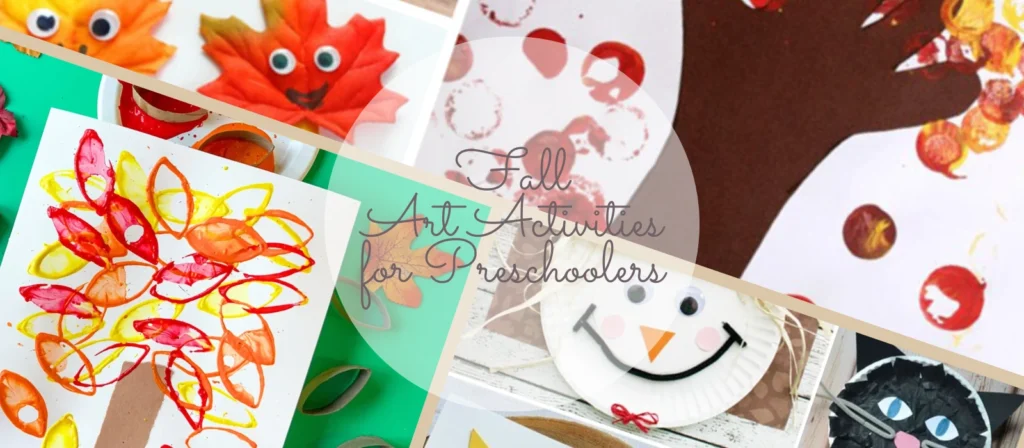
1. Pumpkin Stamping and Jack-O’-Lantern Collages
Use half apples or sponges dipped in orange paint to stamp pumpkin shapes. Let kids add triangle eyes and jagged mouths using black paper cutouts. These pumpkin art activities for preschoolers are great for practicing shape recognition and seasonal vocabulary.
2. Leaf Rubbing and Fall Tree Art
Collect real leaves and place them under thin paper for crayon rubbings. Or make tree silhouettes with sponge painting techniques and multicolor tempera to reflect autumn foliage. These fall tree art activities for preschoolers connect children with nature and stimulate observation skills.
3. Thanksgiving Turkey Crafts
Let preschoolers create turkeys using handprints, feathers, and googly eyes. Try coffee filter feather painting or paper plate turkeys to build storytelling around gratitude. These thanksgiving art activities for preschoolers encourage reflection and thematic learning.
4. Apple and Harvest-Themed Painting
Use apples to stamp prints on paper, or create apple trees with torn tissue paper. Harvest art can also include basket collages, scarecrow figures, and corn kernel mosaics. Great for fine motor development and cultural understanding.
5. Letter F, T, A Fall Art Focus
Incorporate letters with “F is for Fall,” “T is for Tree,” or “A is for Apple” crafts. These help reinforce seasonal vocabulary and alphabet recognition in fun, memorable ways.
Winter Art Activities for Preschoolers
Winter is a magical time for preschoolers, filled with holidays, snowflakes, and cozy indoor crafts. This season offers endless inspiration for hands-on learning and sensory exploration. Art activities for preschoolers during winter help them connect to seasonal changes and build creative confidence even during colder months.
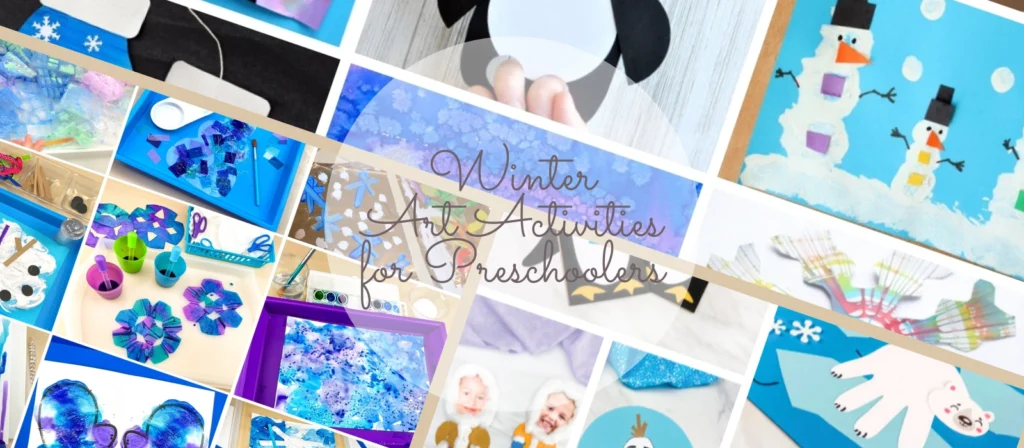
1. Snowman Building with Cotton Balls
Children can create snowman collages using cotton balls, felt scarves, and googly eyes. Use black construction paper as the background for a strong contrast. This activity promotes tactile exploration, pattern recognition, and fine motor precision.
2. Penguin and Polar Bear Painting
Provide blue, white, and black paint to create snowy habitats with adorable penguins and polar bears. Add glitter for icy effects or let kids paint with sponges to simulate snowy textures. These animal art activities for preschoolers also support winter animal studies.
3. Winter Tree Fingerprint Art
Have preschoolers stamp bare winter trees using brown marker lines and white fingerprints for snow. Add birds or mittens for extra detail. This activity enhances observation of seasonal nature and encourages storytelling.
4. Holiday Art: Christmas, Hanukkah, and Kwanzaa Crafts
Create multicultural art stations for each celebration. Preschoolers can decorate paper menorahs, Kwanzaa mats with red/green/black patterns, or simple Christmas trees with stickers and glitter. These winter holiday art activities promote diversity and cultural appreciation.
5. Letter W, J, P Crafts for Winter Themes
Incorporate letters with activities like “W is for Winter,” “J is for Jacket,” and “P is for Penguin.” These integrate language development with seasonal concepts in a fun and memorable way.
6. Snowflake Cutting and Process Art
Use folded paper for symmetrical snowflake cutting, or let kids create snowstorms with spattered white paint on blue backgrounds. These process-based art activities let children explore symmetry, contrast, and cause-and-effect.
Holiday & Special Theme Art Activities for Preschoolers
Beyond the seasons, holidays and special themes bring exciting opportunities for creative expression and learning. These art activities for preschoolers not only celebrate events and milestones but also reinforce values like love, family, friendship, and diversity.
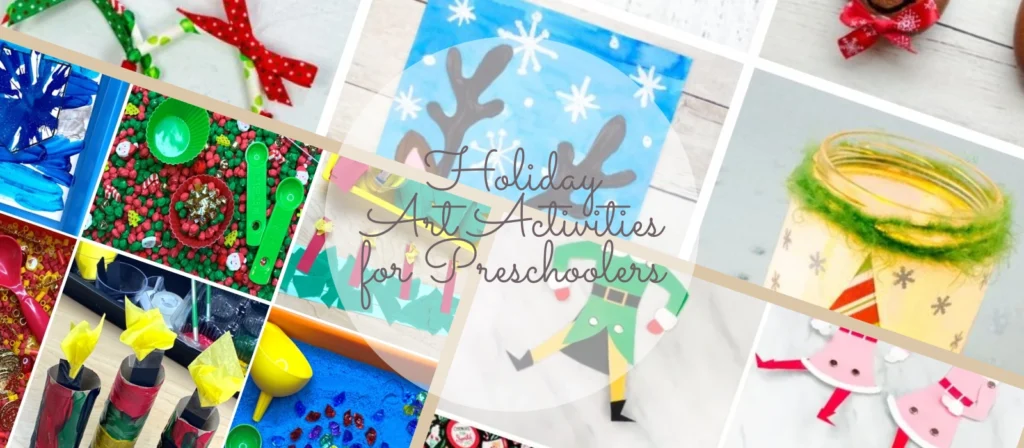
1. Valentine’s Day Heart Crafts
Preschoolers love creating valentines! Use red and pink paper, glitter, doilies, and stickers to make heart cards or heart wreaths. These art activities enhance emotional intelligence and allow children to express appreciation for loved ones.
2. St. Patrick’s Day Rainbows and Shamrocks
Help kids paint rainbows using finger paints or sponge strips, then add cotton balls for clouds. Shamrock stamping using green peppers cut into three-leaf shapes is a fun way to explore plant shapes and color recognition.
3. Mother’s Day and Father’s Day Keepsakes
Create handprint flower bouquets, “World’s Best Mom/Dad” picture frames, or fingerprint art cards. These preschool art activities encourage gratitude, identity, and connection to family values.
4. Grandparents Day Portraits
Let children draw or paint portraits of their grandparents, adding yarn for hair and buttons for eyes. This activity supports personal identity and narrative skills.
5. Friendship-Themed Art Projects
Design friendship bracelets using beads and pipe cleaners, or create “Friendship Trees” where each leaf represents a classmate. These social-emotional activities are especially useful at the beginning of the school year.
6. Graduation Crafts
Create paper graduation caps, memory books, or “When I Grow Up” drawings. These projects reflect on accomplishments and help preschoolers build self-confidence.
Discover more themed art inspiration at Fun-a-Day.
7. All About Me Art Activities
Let each child decorate a life-sized self-portrait, collage their favorite things, or draw their family. These “All About Me” art activities for preschoolers promote self-awareness and language development while encouraging kids to appreciate their uniqueness.
Art activities for preschoolers around holidays and special topics add meaningful context to their creative efforts. They help make celebrations more inclusive, boost emotional understanding, and provide opportunities for deep reflection even in simple art.
ABC and Learning Concept Art Activities for Preschoolers
Integrating literacy and academic themes into creative tasks makes learning both memorable and enjoyable. ABC art activities for preschoolers are especially effective for early reading readiness, sound recognition, and fine motor practice.
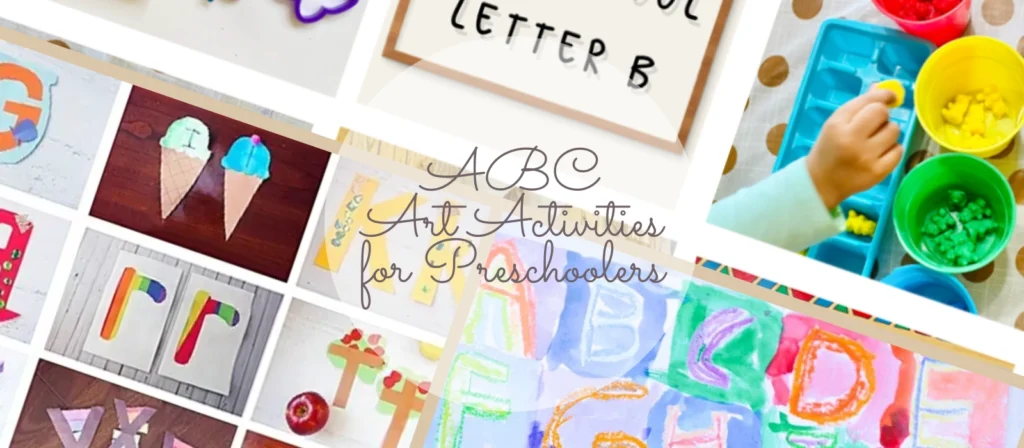
1. A–Z Letter Crafts
Create a project for each alphabet letter: “A is for Apple,” “B is for Bear,” “C is for Car,” and so on. These alphabet art activities for preschoolers reinforce phonics and vocabulary with hands-on experiences. Use letter stencils, foam shapes, or draw large bubble letters that children decorate with related materials.
2. Name Art Activities
Have children write or trace their names and decorate them using collage, stickers, or fingerprints. This helps with name recognition and letter formation, while building a sense of identity and ownership.
3. Number and Counting Crafts
Integrate counting into crafts such as “Five Little Ducks” puppets, number collages, or dot painting to match quantities. These preschool art activities develop early math concepts alongside visual creativity.
4. Five Senses Art Projects
Use texture-based materials for “touch” collages, scented paints for “smell,” sound-makers like rice shakers for “hearing,” and even taste-safe paint recipes for “taste” explorations. These five senses art activities for preschoolers connect sensory learning with vocabulary and descriptive language.
5. Color and Shape Collage
Create color-themed days where kids make red collages using red items, or shape scavenger hunts followed by art using those shapes. These activities improve categorization skills, visual perception, and sorting abilities.
6. Language Arts Integration Through Story Art
After reading a picture book, children can draw or craft scenes from the story, make puppets for retelling, or illustrate their own story pages. These language arts activities for preschoolers support comprehension, sequencing, and storytelling.
7. Process Art for Literacy
Use watercolor blotting, salt painting, and squeegee techniques to form abstract letters or sound collages. Emphasizing the process over the outcome fosters risk-taking, curiosity, and creative problem-solving.
For more literacy art ideas, visit The Imagination Tree.
By incorporating academic themes like letters, numbers, and senses into creative projects, these art activities for preschoolers help bridge the gap between play and foundational learning. They turn abstract concepts into concrete experiences children can see, touch, and remember.
Animal & Nature-Inspired Art Projects for Preschoolers
Children are naturally fascinated by animals and the world around them, making animal and nature themes a perfect foundation for art activities for preschoolers. These topics support science learning, empathy, and an appreciation for the environment.
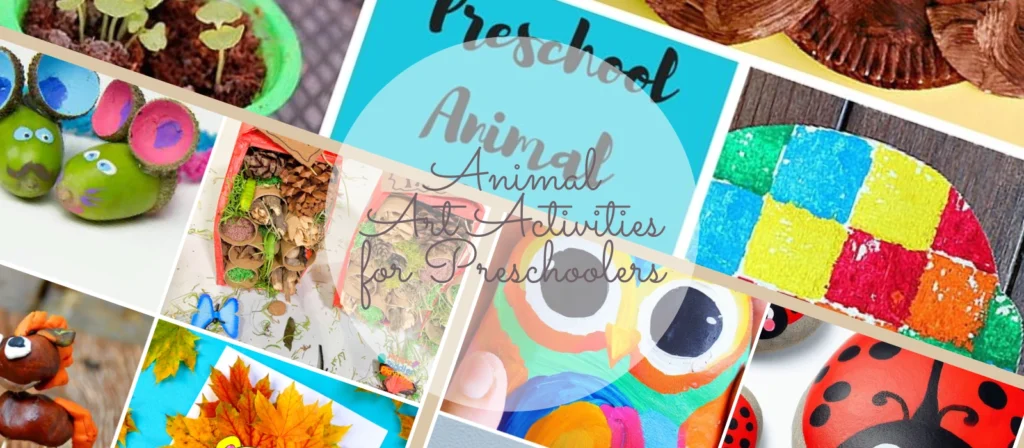
1. Farm Animal Crafts
From cotton ball sheep to piggy masks, farm animal art introduces preschoolers to barnyard creatures while building cutting, gluing, and drawing skills. Try cow spot stamping or chicken feather collages for fun variety.
2. Zoo Animal Art Projects
Use paper plates to make lions with yarn manes, or tissue paper to decorate elephant ears. Preschoolers can also use clay or playdough to model their favorite zoo animals. These activities often lead to imaginative storytelling.
3. Insect and Bug Art
Create bees from toilet paper rolls, butterfly symmetry paintings, or ladybug counting cards. Bug-themed art activities for preschoolers are great for teaching life cycles, symmetry, and even basic math skills.
4. Reptile and Amphibian Crafts
Snake patterns with dot markers or turtle shells made from coffee filters help kids explore textures, patterns, and animal environments. These crafts also support discussions on habitats and animal classification.
5. Woodland Creatures and Hibernation Art
Paint owls with pinecones, make hedgehogs using paper and toothpicks, or create a hibernation cave diorama. These projects tie beautifully into fall and winter seasonal themes.
6. Bird and Nest Crafts
Encourage preschoolers to make nests using natural materials or yarn and glue. Bird masks or feather painting helps enhance fine motor control and nature observation skills.
7. Tree and Gardening Projects
Create handprint trees for each season, seed packet collages, or leaf stamping art. Gardening-themed art activities for preschoolers connect them to the cycles of nature and promote environmental awareness.
By using animals and nature as the inspiration for creativity, these art activities for preschoolers combine environmental learning with tactile, expressive experiences that make a lasting impression.
Transportation & Community Helpers Art Activities for Preschoolers
Transportation and real-world roles fascinate young children. These themes make excellent subjects for art activities for preschoolers by combining imaginative play with recognition of everyday people and machines.
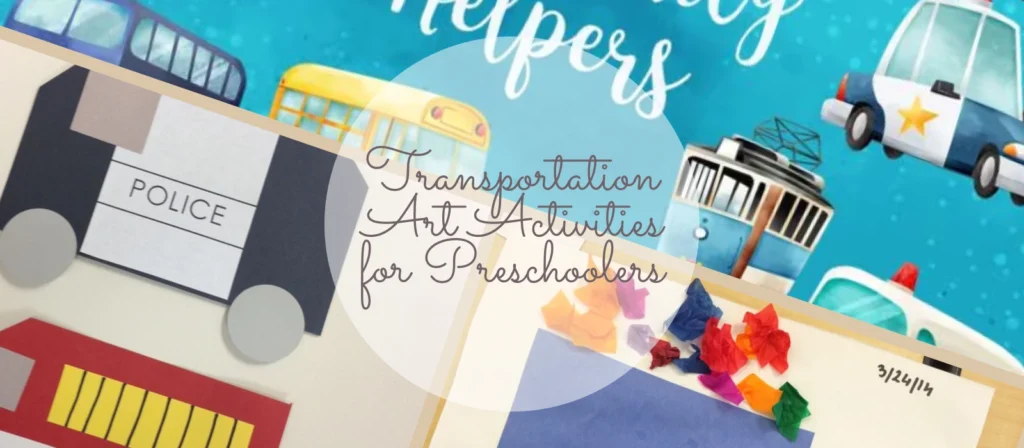
1. Car, Train, and Airplane Crafts
Use cardboard, paper plates, or tissue boxes to create colorful cars and trains. For airplanes, fold paper gliders or use clothespins and popsicle sticks. These transportation art activities for preschoolers help reinforce concepts of motion, travel, and direction.
2. Fire Truck and Police Car Art
Let children paint fire trucks using sponges and red paint, or create police badges from foil and construction paper. These crafts can align with fire safety week or community awareness units.
3. Bus and School Vehicle Painting
Use yellow paper and circles for wheels to construct simple buses. Add faces in the windows to practice counting or emotions. Great for back-to-school or transportation week themes.
4. Community Helpers Puppet Making
Turn paper bags into characters like teachers, doctors, firefighters, and mail carriers. Kids can decorate with uniforms and tools to spark dramatic play and gratitude for real-world helpers.
5. Dentist and Doctor Tools Craft
Cut out paper teeth and glue them onto a smile, or create tiny doctor kits with cotton swabs, band-aid stickers, and paper stethoscopes. These crafts demystify medical roles and teach hygiene.
6. Construction Worker and Builder Art
Use shapes to design construction trucks, build towers with paper blocks, or create builder hats from paper bowls. These construction art activities for preschoolers highlight teamwork and spatial reasoning.
For more on community-themed projects, visit Teach Preschool.
Art activities for preschoolers focused on transportation and community roles deepen children’s understanding of their environment while encouraging creativity, empathy, and vocabulary development.
Creative & Process Art Activities for Preschoolers
Not all preschool art needs to follow a holiday or thematic structure. Sometimes, the most meaningful learning comes from the process itself. Creative and process-based art activities for preschoolers emphasize exploration, freedom, and sensory discovery.
1. Finger Painting and Texture Play
Provide children with a range of tactile materials such as finger paints, sponges, cotton balls, and bubble wrap. Let them explore mixing colors, layering textures, and leaving impressions without aiming for a final product. This open-ended process builds confidence and fine motor skills.
2. Nature-Inspired Process Art
Go on a nature walk and collect leaves, twigs, stones, or flower petals. Then use them for stamping, printing, or assembling loose-part collages. These activities foster a deep connection to nature while encouraging pattern recognition and spatial awareness.
3. Color Mixing Experiments
Set up a station with primary colors and let kids explore mixing secondary hues. Try color-dropping with droppers on coffee filters or blending watercolors. These art activities for preschoolers naturally incorporate early science concepts.
4. Abstract Art with Unusual Tools
Use toothbrushes, squeegees, combs, or toy wheels to paint and create abstract patterns. Encourage children to describe what they see or feel as they experiment. These exercises support self-expression and language development.
5. Salt and Watercolor Painting
Draw with glue on heavy paper and sprinkle with salt. Once dried, have preschoolers paint over the salt to watch the colors spread and absorb. This mesmerizing process is both sensory and artistic, teaching cause and effect.
6. Recycled and Found Materials Collage
Offer a range of safe recycled items: bottle caps, cardboard, fabric scraps, and ribbon. Let kids build imaginative structures or pictures freely. These creative arts activities for preschoolers also teach sustainability and reuse.
Creative and process-based art activities for preschoolers shift the focus from the final product to the joy of discovery. They allow each child to express their individuality while strengthening cognitive and sensory skills in a stress-free environment.
Classroom Setup Tips for Preschool Art Activities
A well-prepared classroom can make all the difference when implementing successful art activities for preschoolers. From organizing supplies to creating inviting workspaces, your environment should encourage exploration while ensuring safety and accessibility for every child.
1. Designate an Art Zone
Create a defined area in the classroom just for art. Use child-sized tables, washable floors, and sturdy chairs to help children feel comfortable and independent. Post visual cues like color charts, shape posters, or inspiration walls to stimulate creativity.
2. Use Easy-to-Access Storage
Keep paints, brushes, paper, and materials in labeled bins or open shelving. Clear containers allow preschoolers to make choices and learn responsibility in selecting their own tools. Add picture labels for non-readers.
3. Offer a Mix of Materials
Include a range of media: crayons, markers, glue, scissors, clay, recyclable items, and natural elements. Rotating materials every few weeks keeps interest high and aligns with seasonal art themes.
4. Prioritize Safety and Clean-Up
Provide smocks or old shirts, use non-toxic art supplies, and teach basic clean-up routines. Place wipes and trash bins within reach and keep water stations nearby for hand washing.
5. Foster Independence
Use step-by-step picture guides, visual schedules, or laminated instruction cards so children can work with minimal adult help. Provide enough tools for each child to reduce waiting and support engagement.
6. Display Children’s Work
Set up bulletin boards or hanging strings with clips to showcase finished projects. Displaying art builds confidence and reinforces that creative expression is valued in your classroom.
By thoughtfully organizing your environment, you ensure that art activities for preschoolers are smooth, engaging, and developmentally appropriate. A well-designed art area not only supports learning—it also inspires joy and creative freedom.

How XIHA Furniture Supports Preschool Creativity
At XIHA Furniture, we understand that an inspiring classroom starts with the right foundation—furniture that works for young learners, teachers, and creative spaces alike. That’s why we specialize in safe, durable, and affordable preschool furniture designed to enhance art activities for preschoolers and promote independence in every learning corner.
1. Purpose-Built Art Furniture
Our child-sized art tables, easels, and storage units are designed for safety and accessibility. Rounded corners, easy-to-clean surfaces, and stable designs help ensure that kids can focus on creativity without distractions or hazards.
2. Organized and Flexible Layouts
From mobile supply trolleys to adjustable shelving, XIHA Furniture helps educators create modular setups that evolve with changing classroom themes. This flexibility is ideal for rotating seasonal and thematic art activities throughout the year.
3. Bulk Orders for Education Providers
We offer large-scale solutions for kindergartens, preschools, and early learning centers across North America, Europe, and Australia. Our direct-from-factory model allows for competitive pricing without sacrificing quality.
4. B2B One-Stop Service
As a manufacturer with five production lines, we provide full B2B support—from selection to shipping. Our clients, like preschool owners and early childhood education organizations, count on us for efficient lead times, safe materials, and compliance with international certifications.
5. Designed for Daily Use
Our products are built to withstand the rigors of daily classroom life. Whether it’s messy painting days or sensory-heavy process art sessions, XIHA Furniture delivers reliability you can count on—day after day.
Visit XIHA Furniture’s official website to explore our full preschool furniture collection.
With the right space and support, creativity flourishes. XIHA Furniture is proud to help schools around the world bring meaningful, developmentally rich art activities for preschoolers to life—one well-designed space at a time.
Conclusion
Art activities for preschoolers are far more than fun—they are foundational to learning, development, and joyful expression. From spring butterflies to winter snowmen, from holiday hearts to imaginative process art, each creative project helps build the skills that matter most: communication, coordination, confidence, and curiosity.
With the right environment, tools, and guidance, young children thrive as artists and thinkers. At XIHA Furniture, we are committed to helping educators create beautiful, functional classrooms that inspire creativity year-round.
Whether you’re planning your next seasonal craft or designing a new preschool space, let this guide—and our furniture—support your mission to nurture young minds through art.



